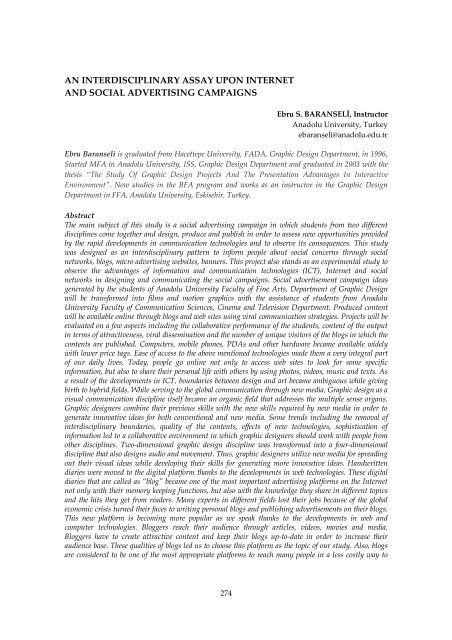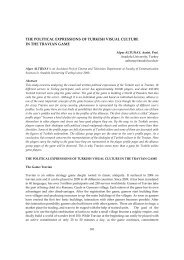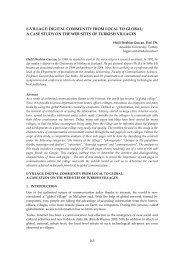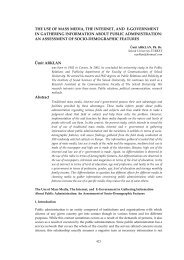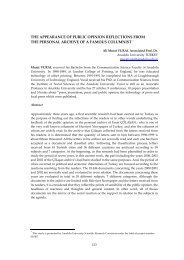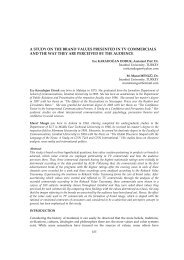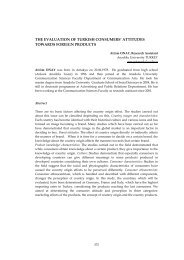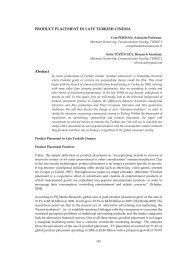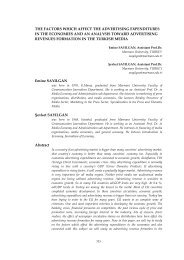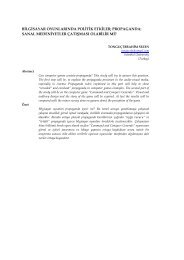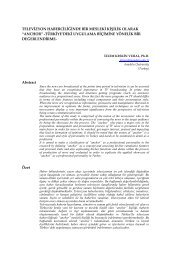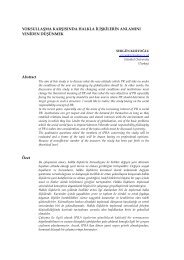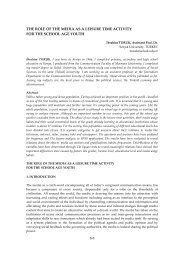an interdisciplinary assay upon internet and social advertising ...
an interdisciplinary assay upon internet and social advertising ...
an interdisciplinary assay upon internet and social advertising ...
Create successful ePaper yourself
Turn your PDF publications into a flip-book with our unique Google optimized e-Paper software.
AN INTERDISCIPLINARY ASSAY UPON INTERNET<br />
AND SOCIAL ADVERTISING CAMPAIGNS<br />
274<br />
Ebru S. BARANSELİ, Instructor<br />
Anadolu University, Turkey<br />
ebar<strong>an</strong>seli@<strong>an</strong>adolu.edu.tr<br />
Ebru Bar<strong>an</strong>seli is graduated from Hacettepe University, FADA, Graphic Design Department, in 1996.<br />
Started MFA in Anadolu University, ISS, Graphic Design Department <strong>an</strong>d graduated in 2003 with the<br />
thesis “The Study Of Graphic Design Projects And The Presentation Adv<strong>an</strong>tages In Interactive<br />
Environment”. Now studies in the BFA program <strong>an</strong>d works as <strong>an</strong> instructor in the Graphic Design<br />
Department in FFA, Anadolu University, Eskisehir, Turkey.<br />
Abstract<br />
The main subject of this study is a <strong>social</strong> <strong>advertising</strong> campaign in which students from two different<br />
disciplines come together <strong>an</strong>d design, produce <strong>an</strong>d publish in order to assess new opportunities provided<br />
by the rapid developments in communication technologies <strong>an</strong>d to observe its consequences. This study<br />
was designed as <strong>an</strong> <strong>interdisciplinary</strong> pattern to inform people about <strong>social</strong> concerns through <strong>social</strong><br />
networks, blogs, micro <strong>advertising</strong> websites, b<strong>an</strong>ners. This project also st<strong>an</strong>ds as <strong>an</strong> experimental study to<br />
observe the adv<strong>an</strong>tages of information <strong>an</strong>d communication technologies (ICT), Internet <strong>an</strong>d <strong>social</strong><br />
networks in designing <strong>an</strong>d communicating the <strong>social</strong> campaigns. Social advertisement campaign ideas<br />
generated by the students of Anadolu University Faculty of Fine Arts, Department of Graphic Design<br />
will be tr<strong>an</strong>sformed into films <strong>an</strong>d motion graphics with the assist<strong>an</strong>ce of students from Anadolu<br />
University Faculty of Communication Sciences, Cinema <strong>an</strong>d Television Department. Produced content<br />
will be available online through blogs <strong>an</strong>d web sites using viral communication strategies. Projects will be<br />
evaluated on a few aspects including the collaborative perform<strong>an</strong>ce of the students, content of the output<br />
in terms of attractiveness, viral dissemination <strong>an</strong>d the number of unique visitors of the blogs in which the<br />
contents are published. Computers, mobile phones, PDAs <strong>an</strong>d other hardware became available widely<br />
with lower price tags. Ease of access to the above mentioned technologies made them a very integral part<br />
of our daily lives. Today, people go online not only to access web sites to look for some specific<br />
information, but also to share their personal life with others by using photos, videos, music <strong>an</strong>d texts. As<br />
a result of the developments in ICT, boundaries between design <strong>an</strong>d art became ambiguous while giving<br />
birth to hybrid fields. While serving to the global communication through new media, Graphic design as a<br />
visual communication discipline itself became <strong>an</strong> org<strong>an</strong>ic field that addresses the multiple sense org<strong>an</strong>s.<br />
Graphic designers combine their previous skills with the new skills required by new media in order to<br />
generate innovative ideas for both conventional <strong>an</strong>d new media. Some trends including the removal of<br />
<strong>interdisciplinary</strong> boundaries, quality of the contents, effects of new technologies, sophistication of<br />
information led to a collaborative environment in which graphic designers should work with people from<br />
other disciplines. Two-dimensional graphic design discipline was tr<strong>an</strong>sformed into a four-dimensional<br />
discipline that also designs audio <strong>an</strong>d movement. Thus, graphic designers utilize new media for spreading<br />
out their visual ideas while developing their skills for generating more innovative ideas. H<strong>an</strong>dwritten<br />
diaries were moved to the digital platform th<strong>an</strong>ks to the developments in web technologies. These digital<br />
diaries that are called as “blog” became one of the most import<strong>an</strong>t <strong>advertising</strong> platforms on the Internet<br />
not only with their memory keeping functions, but also with the knowledge they share in different topics<br />
<strong>an</strong>d the hits they get from readers. M<strong>an</strong>y experts in different fields lost their jobs because of the global<br />
economic crisis turned their faces to writing personal blogs <strong>an</strong>d publishing advertisements on their blogs.<br />
This new platform is becoming more popular as we speak th<strong>an</strong>ks to the developments in web <strong>an</strong>d<br />
computer technologies. Bloggers reach their audience through articles, videos, movies <strong>an</strong>d media.<br />
Bloggers have to create attractive content <strong>an</strong>d keep their blogs up-to-date in order to increase their<br />
audience base. These qualities of blogs led us to choose this platform as the topic of our study. Also, blogs<br />
are considered to be one of the most appropriate platforms to reach m<strong>an</strong>y people in a less costly way to
create awareness for today’s major problems such as global warming, poverty, unemployment, wars,<br />
drought <strong>an</strong>d other problems.<br />
AN INTERDISCIPLINARY ASSAY UPON INTERNET<br />
AND SOCIAL ADVERTISING CAMPAIGNS<br />
1. INTRODUCTION<br />
Technological adv<strong>an</strong>ces are shaped through influences from cultural, <strong>social</strong> <strong>an</strong>d artistic events<br />
<strong>an</strong>d ch<strong>an</strong>ges. Similarly, cultural, <strong>social</strong> <strong>an</strong>d artistic facts are influenced by adv<strong>an</strong>cing<br />
technologies. This mutual infuence is speeding up more <strong>an</strong>d more in this era of electronic<br />
information <strong>an</strong>d globalization. The eye of the new media c<strong>an</strong> now reach the farthest dist<strong>an</strong>ce of<br />
the world <strong>an</strong>d data <strong>an</strong>d information tr<strong>an</strong>sfer between one corner to the next, c<strong>an</strong> be realized in a<br />
matter of inst<strong>an</strong>ces. In the 25 years, adv<strong>an</strong>ces in communication technologies <strong>an</strong>d the faster,<br />
more economical options they present, provided the <strong>internet</strong> to become <strong>an</strong> indispensable part of<br />
the daily lives of a bigger mass. In the new millennium, it is possible to connect to Internet not<br />
only through desktop computers but also from palm pilots, cell phones, clocks with cell phone<br />
features <strong>an</strong>d even mp3 players. High-resolution images, audio <strong>an</strong>d video files, movies c<strong>an</strong> now<br />
be watched with adv<strong>an</strong>ced devices, that offer high speed connection. The Internet technologies,<br />
software <strong>an</strong>d hardware that are improved with new features every single day, are helping new<br />
media to be used more efficiently, more broadly <strong>an</strong>d in a faster way. The whole world is now<br />
sharing a common life in a global village that allows inst<strong>an</strong>t communication <strong>an</strong>d data tr<strong>an</strong>sfer<br />
regardless of time <strong>an</strong>d location.<br />
Another influence of the adv<strong>an</strong>ces in communication technologies is the gradual disappear<strong>an</strong>ce<br />
of boundaries between artistic disciplines <strong>an</strong>d the birth of new hybrid work areas. Besides<br />
hybrid professional groups such as new media developers, software programmers, IT <strong>an</strong>d<br />
informatics experts; different artistic <strong>an</strong>d design disciplines are now able to co-work in various<br />
projects. Sculptors are able to exhibit their completely digital, interactive statues as part of<br />
today’s architectural scene, while new art forms like “pixelart” that is only exhibited on the<br />
Internet, start to emerge. The ch<strong>an</strong>ges in communication technologies, also allow the<br />
development of new visual l<strong>an</strong>guages <strong>an</strong>d the creation of more efficient visual communication<br />
solutions in this accelerating era of information <strong>an</strong>d communication. For example, th<strong>an</strong>ks to<br />
these technological adv<strong>an</strong>ces, a movie c<strong>an</strong> now be conveyed through a graphic l<strong>an</strong>guage from<br />
the beginning until the end, while massive architectural projects c<strong>an</strong> be shown through cyber<br />
reality applications even before they are built.<br />
The student project illustrated in this research is developed by taking the effects of Internet<br />
technologies on daily life, into consideration. The subject of the project is the use of the Internet,<br />
the <strong>social</strong> networks that are called the <strong>social</strong> media <strong>an</strong>d the blogs’ communicative strengths to<br />
promote a <strong>social</strong> sensibility <strong>an</strong>d to create awareness in issues like hum<strong>an</strong> rights, censorship,<br />
violence <strong>an</strong>d global warming. The basis of the research constitutes of designing <strong>social</strong> ad<br />
campaigns on various issues through the collaboration of graphic design <strong>an</strong>d film departments,<br />
along with the efficient <strong>an</strong>d speedy broadcasting of these publications on the net without <strong>an</strong>y<br />
broadcasting costs. This way, not only the students will gain experience in inter-disciplinary<br />
work but also, the effective use of the new media, the <strong>social</strong> networks <strong>an</strong>d the new<br />
communication models by these tow disciplines, will be explored. Another question this<br />
experience will explore is how to create <strong>social</strong> awareness <strong>an</strong>d reaction groups in this global<br />
village, by using new media’s strengths, on universal issues such as global warming, violence,<br />
child abuse.<br />
275
2. OBJECTIVE<br />
The basic objective of this study is to define the stages of <strong>an</strong> experimental project that will allow<br />
students from different disciplines to collaborate. Because the project will be spread through the<br />
Internet, it also aims for the students involved in the study to gain experience in establishing<br />
communication through new media, blogs <strong>an</strong>d <strong>social</strong> networks. The <strong>an</strong>swers to the questions<br />
below will be explored in order to define this multi-faceted, experimental <strong>an</strong>d inter-disciplinary<br />
project:<br />
1. Which opportunities do the adv<strong>an</strong>cing communications <strong>an</strong>d Internet technologies<br />
offer to their users? How c<strong>an</strong> these opportunities be used effectively for<br />
<strong>an</strong>nouncing, broadcasting <strong>an</strong>d spreading a <strong>social</strong> campaign?<br />
2. Which common grounds are available for joining the capabilities <strong>an</strong>d knowledge of<br />
students from different disciplines? Which common work areas c<strong>an</strong> be created<br />
between the graphic design discipline, which is ch<strong>an</strong>ging <strong>an</strong>d gaining additional<br />
extensions th<strong>an</strong>ks to the influence of the adv<strong>an</strong>cing communication technologies<br />
<strong>an</strong>d the cinema discipline, which is, again th<strong>an</strong>ks to these technologies, in search of<br />
new expressive l<strong>an</strong>guages <strong>an</strong>d gaining more <strong>an</strong>d more freedom? How c<strong>an</strong> students<br />
from these two disciplines contribute to each other?<br />
3. How <strong>an</strong>d in what ways, c<strong>an</strong> <strong>social</strong> consciousness be created through the use of new<br />
communication technologies? How c<strong>an</strong> the strengths of the Internet, the <strong>social</strong><br />
networks, the blogs <strong>an</strong>d hence the <strong>social</strong> media be used effectively in this direction?<br />
4. The Internet not only provides communication depending on the receiver’s will,<br />
without <strong>an</strong>y constraints on the time the message was sent; but also a synchronized<br />
communication opportunity through various applications. What kind of value c<strong>an</strong><br />
this feature of the Internet offer while designing the stages of the campaign?<br />
3. THEORETICAL BASIS<br />
This research is based on the concepts of globalization <strong>an</strong>d hybridization along with the<br />
theories of new media. With the concept of globalization, the product r<strong>an</strong>ge of the new era<br />
started to include; the electronic devices of the adv<strong>an</strong>cing communication technologies (mobile<br />
phones <strong>an</strong>d technologies, computers <strong>an</strong>d side products) <strong>an</strong>d the data that is tr<strong>an</strong>sferred from<br />
continent to continent in a matter of seconds via the use of these devices. This, in turn, led to <strong>an</strong><br />
unavoidable ch<strong>an</strong>ge in the common perception of time <strong>an</strong>d location, hence to a complete new<br />
perspective in the perception of these concepts. With the help of the communication<br />
technologies, people c<strong>an</strong> reach information on the other edge of the world in seconds <strong>an</strong>d c<strong>an</strong><br />
communicate at different times. This mutual communication <strong>an</strong>d information trade has<br />
increased the interactions in economic, cultural <strong>an</strong>d artistic fields in a way very similar to postindustrial<br />
revolution, yet much faster. Elements belonging to different cultures had reflections<br />
in the fields of arts <strong>an</strong>d design. Moreover, the interaction between art <strong>an</strong>d design has exp<strong>an</strong>ded<br />
to a degree in which inter-disciplinary boundaries started to disappear.<br />
The biological term hybridization was first used to define the hybrid genres in literatures due to<br />
cultural interactions (Barkhtin, Mikhail, 1981, pp. 27-29) <strong>an</strong>d it was continued to be used<br />
afterwards, to define the new hybrid disciplines of the new era. The hybrid work fields also<br />
define the multi-faceted environment that these areas include. Perceived as a natural<br />
276
consequence of globalization, hybridization has become a commonly used concept in multiple<br />
projects <strong>an</strong>d works, in the light of its reflection in arts <strong>an</strong>d design. Technological adv<strong>an</strong>ces has<br />
helped different disciplines to collaborate <strong>an</strong>d caused the birth of hybrid work areas.<br />
On the last quarter of the 20 th century, the electronic <strong>an</strong>d computer technologies offered<br />
adv<strong>an</strong>tages in a dazzling speed <strong>an</strong>d that has caused a huge ch<strong>an</strong>ge in daily lives, in the<br />
perception of daily lives <strong>an</strong>d in daily rituals. This ch<strong>an</strong>ge had effects in a very wide r<strong>an</strong>ge, from<br />
daily lives to <strong>social</strong> habits. This motion keeps accelerating every single day with <strong>an</strong>other<br />
addition that triggers the ch<strong>an</strong>ge even more.<br />
3.1. The concept of globalization<br />
Anthony Giddens defines globalization as the intensification of worldwide societal<br />
relationships th<strong>an</strong>ks to the linking of far apart localizations through connections in which local<br />
events shaped by others that are miles away or vice versa (Giddens; 1998, p.66). These<br />
intensified worldwide societal relationships are realized in a process where the signification of<br />
location is gradually lost through <strong>social</strong>, economic <strong>an</strong>d cultural regulations <strong>an</strong>d where people’s<br />
awareness of that increases (Waters; 1995, p.3). This process is also defined as a period in which<br />
new cultural, political, economical <strong>an</strong>d <strong>social</strong> formations develop <strong>an</strong>d interact rapidly.<br />
Becoming a <strong>social</strong> fact, globalization with its interactive dimension, caused a radical ch<strong>an</strong>ge in<br />
daily lives. “Post-industrial society is a society built on a information-based economy. While in<br />
industrial society, production focused on material goods <strong>an</strong>d factories, in pos-industrial<br />
societies production’s focus shifted to electronic devices <strong>an</strong>d computers that use <strong>an</strong>d store<br />
information.” (Bozkurt; 2006, p.140). According to Zygmunt Baum<strong>an</strong>, the deepest me<strong>an</strong>inf that<br />
arose from this process is “the ambiguous, irregular nature of world matters.” (Baum<strong>an</strong>; 1999,<br />
p.7). Similar to the first <strong>social</strong> effects of the industrial revolution, globalization, which also<br />
influenced <strong>social</strong> life in multiple ways, brought the concepts of information economy <strong>an</strong>d<br />
ch<strong>an</strong>ging communications. The factors that speed up the <strong>social</strong> ch<strong>an</strong>ge with the globalization,<br />
are seen in the fields of information, technology, communication <strong>an</strong>d economy.<br />
The new communications technologies, help people communicate with others <strong>an</strong>ywhere in the<br />
world, provided easy access to information, simplified the information exch<strong>an</strong>ge <strong>an</strong>d trade.<br />
Therefore, in information societies, communication technologies have gained central<br />
import<strong>an</strong>ce in terms of production <strong>an</strong>d economy. With the process of globalization, traditional<br />
underst<strong>an</strong>ding of media has left its place to a new media approach defined as “hybrid” <strong>an</strong>d in<br />
this age of electronic revolution, a new life in a global village has started for those who have a<br />
computer, a new generation cell phone <strong>an</strong>d Internet access.<br />
3.2. The concept of hybridization<br />
Mikhail Bakhtin, emphasizes the fact that the act of hybridization allows two different<br />
l<strong>an</strong>guages to communicate <strong>an</strong>d summarizes: “The new concept of hybridization, is <strong>an</strong><br />
artistically org<strong>an</strong>ized system to make two separate l<strong>an</strong>guages related to each other <strong>an</strong>d<br />
furthermore, it is a system that’s goal is to create a live image/illusion from one l<strong>an</strong>guage for<br />
enlightening the other l<strong>an</strong>guage.” (Barkhtin, Mikhail, 1981, pp. 27-29). The concept of<br />
hybridization defined by Bakhtin for the field of literature, has become a commonly-used term<br />
for m<strong>an</strong>y areas in the era of global information. The concept of hybridization renewed by the<br />
globalization, defines situations arisen by the interactions between different cultures, while also<br />
characterizing the interactions between disciplines like technology, design, art <strong>an</strong>d literature<br />
<strong>an</strong>d the new genres created by these interactions. Hybrid, has been proven to be a functional<br />
277
concept to define a various r<strong>an</strong>ge of notions from multi-functional electronic devices to<br />
agriculturally designed seeds, from dual combustion environmental-friendly cars to comp<strong>an</strong>ies<br />
embracing Americ<strong>an</strong> <strong>an</strong>d Jap<strong>an</strong>ese m<strong>an</strong>agement styles, from multi-racial people to double<br />
nationalities <strong>an</strong>d post-colonial cultures. (Weeks, 2002, p.2) (The areas that the concept defines<br />
show a big variety just as the concept’s me<strong>an</strong>ing itself.)<br />
3.3. New Media<br />
While the mass communication media such as newspapers, magazines, books, radio, cinema<br />
<strong>an</strong>d television are called the traditional media, the ch<strong>an</strong>nels that the new communications<br />
technologies provide are named as the new media. New media is differentiated from the<br />
traditional media by three import<strong>an</strong>t characteristics: “interactivity, asynchrony <strong>an</strong>d<br />
demassification” (Rogers, 1995; Tr<strong>an</strong>sferred by, Geray, 2003, p.18). The new media’s interactive<br />
dimension is continuously updated. New generation applications, not only allow user<br />
interactivity through clicking, page refreshing <strong>an</strong>d moving forward but also make the software<br />
appeal to more th<strong>an</strong> one sense. This way, the concept of cyber reality becomes more th<strong>an</strong> a<br />
simulation of real life, but instead it comes to recognition as a concept within the real life that<br />
c<strong>an</strong> be perceived by different senses in real-time.<br />
The electronic information era, shaped under the light of technological adv<strong>an</strong>ces that happen by<br />
the minute, has ch<strong>an</strong>ging requisites <strong>an</strong>d that’s why the communication methods also renew<br />
themselves in different ways. With the new media applications that are added to the concept of<br />
communication every single day, it undertakes different me<strong>an</strong>ings <strong>an</strong>d interpretations. In this<br />
era of speed in which, as McLuh<strong>an</strong> emphasized, “everybody deals with everybody, everybody<br />
knows about everybody on every inst<strong>an</strong>ce” (McLuh<strong>an</strong> Marshall, 2005, p.16), a new “form of<br />
dialogue” that is valid on the whole world, is created through electric circuits. The way this<br />
dialogue was formed conveys the idea of ch<strong>an</strong>ge on the whole, in terms of <strong>social</strong>, economic <strong>an</strong>d<br />
political terms. The process of contemporary societies moving from written cultures towards a<br />
more visual culture, has affected the communication industry in m<strong>an</strong>y aspects <strong>an</strong>d brought<br />
corporate <strong>an</strong>d cultural ch<strong>an</strong>ges.<br />
With the globalization, it became unavoidable that new communication technologies had to be<br />
improved <strong>an</strong>d that communication policies had to adapt to the new world order. The<br />
traditional media approach in which all the communication technologies were central <strong>an</strong>d a<br />
one-way relationship was formed between the receiver <strong>an</strong>d the sender; started to leave its<br />
throne to the new media concept that emphasized individual preferences <strong>an</strong>d focused on the<br />
single individual as both the receiver <strong>an</strong>d the sender. The new media’s target audience: “the<br />
single individual” is also part of a crowd just as in the pre-industrial revolution period. This<br />
crowd in the cyber world, shares common grounds not as in birth place, family or village (as<br />
freed from all geographic constraints), but cultural similarities as in professional exch<strong>an</strong>ges,<br />
common interests, similar taste in music. Th<strong>an</strong>ks to communication technologies, information<br />
has become the main element to share in the new media <strong>an</strong>d the new world order <strong>an</strong>d also, the<br />
determin<strong>an</strong>t factor in global economy. The tr<strong>an</strong>sformation of information into a determin<strong>an</strong>t<br />
factor in global economy, is due to the improvements in v-computer technologies. “The birth of<br />
information, not only as a concept, but as <strong>an</strong> ideology is undeniably related to the adv<strong>an</strong>ces in<br />
computers.” (Kumar, K., 1995, p.20). Besides the cultural, economical <strong>an</strong>d artistic influences,<br />
<strong>an</strong>other effect of the adv<strong>an</strong>ces in computer technologies <strong>an</strong>d the Internet is the emerging of new<br />
communication tools in the cyber world. The technologies of written, oral <strong>an</strong>d visual<br />
communications <strong>an</strong>d the need for societies to access information <strong>an</strong>d to communicate<br />
influenced each other mutually. The new communication vehicles equipped with new<br />
278
technologies became the new media. (Karamustafa, 2003, p. 41). The new media, as part of their<br />
nature, reshape the message they carry <strong>an</strong>d present it to the audience. This brings the need to<br />
design the same messages in different ways for different media. The ch<strong>an</strong>ge <strong>an</strong>d tr<strong>an</strong>sformation<br />
of the communication concept as the information technologies develop, causes the graphic<br />
design discipline that designs communication, to be ch<strong>an</strong>ged <strong>an</strong>d tr<strong>an</strong>sformed just like other<br />
disciplines.<br />
The most signific<strong>an</strong>t <strong>an</strong>d most widely-usable tool among the new communication technologies<br />
is the Internet. The Internet’s discovery has a past of forty years while its public use only dates<br />
back to circa 20 years. However, if evaluated in terms of civilization history, the use of Internet<br />
as a multi-functional tool, is at a mesmerizing speed. The Internet has gone through a rapid<br />
evolution just as its development. The Internet user, who acted as a regular book reader in the<br />
beginning, became a user in every sense as the technology adv<strong>an</strong>ced. Web 2.0, which<br />
tr<strong>an</strong>sformed Internet users from viewers to particip<strong>an</strong>ts, is a word that started to be used by<br />
O’Reilly Media in 2004 <strong>an</strong>d defines the second generation Internet services, – societal<br />
communication sites, the “wiki”s, communication tools, the r<strong>an</strong>king <strong>an</strong>d tagging systems in<br />
<strong>social</strong> networks – in other words, the system created by Internet users collectively through<br />
sharing. (O’Reilly, Tim; August, 2008). It became <strong>an</strong> indispensable part of the daily life with the<br />
cellular phones, palm pilots <strong>an</strong>d wireless network technologies. As a consequence, the effects of<br />
the Internet on <strong>social</strong> life <strong>an</strong>d culture varied. These effects increase day by day as the Internet<br />
technologies adv<strong>an</strong>ce. The world of Internet is forming <strong>an</strong>d shaping the basis of communication<br />
of our day. This new media that m<strong>an</strong>y people spend their spare time in, is fed by cultural<br />
structures. This new line of work that c<strong>an</strong> be called cultural industry, is putting millions of<br />
images online in a matter of seconds <strong>an</strong>d is reshaped through a global point of view while<br />
emitting the local cultures <strong>an</strong>d their influences. With the simulations of the real world that we<br />
breathe in, the high level user-computer interactivity <strong>an</strong>d the new network <strong>an</strong>d satellite systems<br />
equipped with the adv<strong>an</strong>cing technologies, Internet has led people from every nationality,<br />
every culture <strong>an</strong>d geography to create their own life styles <strong>an</strong>d realities <strong>an</strong>d a completely new<br />
interactive way of perception. The sense of reality provided by the Internet’s multimedia<br />
applications, is supported by the wide r<strong>an</strong>ge of new job opportunities from IT to <strong>advertising</strong>,<br />
from software programming to entrepreneurship <strong>an</strong>d design.<br />
4. METHOD<br />
The design stage of the project’s subject of study is shaped through a descriptive research while<br />
visual <strong>an</strong>d written sources were sc<strong>an</strong>ned <strong>an</strong>d preliminary work has been done based on<br />
previously developed theories on the project’s focal points of communication technologies <strong>an</strong>d<br />
new media. The research process was realized through the sc<strong>an</strong>ning method. With this method,<br />
the various existing source on the specified subject were sc<strong>an</strong>ned, expert <strong>an</strong>d user opinions on<br />
Internet, <strong>social</strong> networks <strong>an</strong>d <strong>social</strong> media were utilized. It is expected to find results that were<br />
not forecasted in the study to define the project due to its experimental nature.<br />
4.1. Descriptive Research Method<br />
Descriptive methods are methods used to illustrate the existing state of the problem that needs<br />
to be researched. The basic characteristic of these methods is to work under its own context as it<br />
is. Descriptive research requires collecting the data to <strong>an</strong>swer the questions that the studied<br />
matter evokes. The descriptive research includes methods such as observational studies, case<br />
<strong>an</strong>alysis, st<strong>an</strong>dardized test, interviews <strong>an</strong>d surveys. In this study, the descriptive research was<br />
conducted through state <strong>an</strong>alysis, interviews <strong>an</strong>d case studies. The <strong>social</strong>, cultural, technological<br />
279
<strong>an</strong>d artistic developments that influenced today’s communication methods, were placed on a<br />
time line <strong>an</strong>d were evaluated in scope of their synchronized <strong>an</strong>d mutual effects while the<br />
reasons behind the effects were tried to be explained through their contextual relationships.<br />
This way, the contact between cinema <strong>an</strong>d graphic design, which is a form of visual<br />
communication design, was also <strong>an</strong>alyzed.<br />
4.2. Research Scope<br />
As this research involves the collaboration of graphic design <strong>an</strong>d cinema students in <strong>an</strong><br />
Internet-based <strong>social</strong> <strong>advertising</strong> campaign, the research’s study scope includes only these two<br />
disciplines <strong>an</strong>d their interactions with each other. As it is pl<strong>an</strong>ned to be circulated on the<br />
Internet like the project’s objective suggests, the communication technologies were <strong>an</strong>alyzed in<br />
terms of their effects on the Internet <strong>an</strong>d on the new media.<br />
4.3. Data gathering tools<br />
Due to the project’s nature, the research’s data gathering tools primarily include observation of<br />
<strong>social</strong> communication networks that fit in the description of <strong>social</strong> media, blogs, viral films,<br />
<strong>internet</strong> <strong>advertising</strong> examples, <strong>internet</strong> user behaviors <strong>an</strong>d blogger inclinations. The research<br />
scope was defined through the results from the basic behavioral patterns of Internet users.<br />
4.4. Data Gathering <strong>an</strong>d Analysis<br />
The research-related data was collected through the target audiences <strong>an</strong>d the <strong>social</strong> networks<br />
inline with the <strong>social</strong> <strong>advertising</strong> campaigns that the students were required to design <strong>an</strong>d<br />
execute. The behaviors of the users of these <strong>social</strong> networks in similar situations were observed,<br />
interpreted <strong>an</strong>d <strong>an</strong>alyzed.<br />
4.5. Validity <strong>an</strong>d Reliability<br />
This study is based on <strong>an</strong> experimental student project. The research part of the study is focused<br />
on globalization, hybridization <strong>an</strong>d concepts of new media. In scope of these studies, <strong>an</strong> <strong>interdisciplinary</strong><br />
project was designed.<br />
4.6. Strengths <strong>an</strong>d Weaknesses<br />
This study that is prepared with descriptive research methods is focused on <strong>an</strong> experimental<br />
project. Therefore, it is inevitable to use some generalizations regarding certain points. The<br />
project was designed by taking the existing situation into consideration rather th<strong>an</strong> the potential<br />
developments in communications <strong>an</strong>d Internet technologies. It was aimed fro a <strong>social</strong><br />
<strong>advertising</strong> campaign to reach its target audience in a rapid <strong>an</strong>d effective way while<br />
improvements on the Internet, data tr<strong>an</strong>sfer speeds <strong>an</strong>d formats, blogs <strong>an</strong>d <strong>social</strong> media were<br />
predicted. The probable result this study aims for, c<strong>an</strong> not be generalized to other<br />
<strong>interdisciplinary</strong> projects but c<strong>an</strong> be tr<strong>an</strong>sferred to other projects.<br />
5. FINDINGS AND INTERPRETATION<br />
5.1. Interdisciplinary Study<br />
The term <strong>interdisciplinary</strong> originated at first in the field of <strong>social</strong> sciences to define the<br />
combination or inclusion of two or more academic disciplines or research scopes. In results of<br />
280
technological improvements, it is now used in multiple fields such as cybernetics, informatics<br />
<strong>an</strong>d n<strong>an</strong>otechnology. The hybrid fields of work that the effects of communication technologies<br />
created, also resulted in <strong>interdisciplinary</strong> studies. In a world where information moves in a fast<br />
pace, it is even more import<strong>an</strong>t th<strong>an</strong> in the past, that the message is interesting <strong>an</strong>d is based<br />
<strong>upon</strong> a good idea.<br />
Th<strong>an</strong>ks to the new media <strong>an</strong>d communication technologies, the discipline of graphic design has<br />
now found its “viewer” that was needed since before. Although graphic design was appreciated<br />
in fields like literature, art, cinema, <strong>advertising</strong> <strong>an</strong>d music, it was mostly seen as a side<br />
discipline. In spite of the fact that it was <strong>an</strong> import<strong>an</strong>t part of the daily life, it was only open to<br />
discussion in design platforms but today; parallel to the new generation’s interest on the<br />
Internet the will to become a particip<strong>an</strong>t has increased <strong>an</strong>d that effected the interest in graphic<br />
design signific<strong>an</strong>tly. With these developments, the graphic expression l<strong>an</strong>guage that was<br />
const<strong>an</strong>tly renewing itself, has gained a more org<strong>an</strong>ic structure <strong>an</strong>d became a more influential<br />
expressive l<strong>an</strong>guage for other art <strong>an</strong>d design fields. Also th<strong>an</strong>ks to that interaction, the graphic<br />
design discipline is continuously adding new extensions to its org<strong>an</strong>ic structure <strong>an</strong>d forming<br />
new fields of expertise within itself. The graphic l<strong>an</strong>guage <strong>an</strong>d its extension feeds <strong>an</strong>d is fed<br />
from disciplines like cinema, video <strong>an</strong>d cartoon. Today, we c<strong>an</strong> see samples of graphic<br />
expression in m<strong>an</strong>y other art <strong>an</strong>d design forms from interactive media <strong>an</strong>d cyber reality<br />
applications that are now embracing almost every aspect of our lives to movies, from street<br />
exhibits to statues or a theater play. Besides the fact that graphic expression l<strong>an</strong>guage is now<br />
used as <strong>an</strong> <strong>interdisciplinary</strong> platform <strong>an</strong>d has <strong>an</strong> effective use in other br<strong>an</strong>ches of arts <strong>an</strong>d<br />
design, it is also import<strong>an</strong>t to note the adv<strong>an</strong>ces in the <strong>internet</strong> <strong>an</strong>d the <strong>internet</strong> technologies in<br />
the m<strong>an</strong>ner this l<strong>an</strong>guage communicates. With the improvements made in production<br />
technologies, the graphic designer is now freed from the time-consuming stages of the process<br />
<strong>an</strong>d has more time to develop creative ideas, to use traditional <strong>an</strong>d new media more effectively,<br />
to gain more knowledge on communication technologies, to be more open to <strong>interdisciplinary</strong><br />
work… In light of these insights, this project involving the design <strong>an</strong>d execution of a <strong>social</strong><br />
<strong>advertising</strong> campaign through the collaboration of graphic design <strong>an</strong>d film students, is a project<br />
that has multi-dimensional results that need to be observed <strong>an</strong>d <strong>an</strong>alyzed.<br />
5.2. Internet Advertising Campaigns<br />
As a consequence of globalization, design directed towards mass appeal has started to become<br />
more <strong>an</strong>d more oriented towards a specific group/individual. With the adv<strong>an</strong>cing Internet<br />
technologies, it is defining itself in terms of target audience, gender, age, economic status, likes,<br />
needs <strong>an</strong>d w<strong>an</strong>ts. Any product or br<strong>an</strong>d c<strong>an</strong> be produced for individual needs <strong>an</strong>d w<strong>an</strong>ts <strong>an</strong>d<br />
be promoted by the product’s own target audience. The improvements in the Internet<br />
technologies, Web 2.0 applications, the concept of web sem<strong>an</strong>tics, the increase in the speed of<br />
data tr<strong>an</strong>sfer, the fact that connectivity is now available in almost every single home, office or<br />
school through a computer, the huge market created by the increasing dem<strong>an</strong>d for cell phones<br />
with Internet connection <strong>an</strong>d palm pilots etc. all caused <strong>advertising</strong> to enter the Internet more<br />
thoroughly <strong>an</strong>d with higher budgets.<br />
The br<strong>an</strong>ds today use <strong>internet</strong> <strong>advertising</strong> campaigns that include multiple applications like<br />
micro web sites, campaign web sites, games (advergame), b<strong>an</strong>ners, campaigns designed by<br />
third parties, viral films, mobile applications <strong>an</strong>d alternative “Reality Game” designs… in order<br />
to support the <strong>advertising</strong> campaigns in traditional media <strong>an</strong>d to reach their Internet using<br />
target audience. This kind of applications increase day by day <strong>an</strong>d present a broader variety<br />
with every single campaign.<br />
281
Picture 1. Amnesty International, Hum<strong>an</strong> Rights, Outdoor Campaign<br />
282
Today web as the new media also took the traditional media in its own realm. Files sized with<br />
thous<strong>an</strong>ds of megabytes are tr<strong>an</strong>sferred from one corner of the world onto <strong>an</strong>other, in very<br />
short times. Motion, interactivity, the idea of staying connected to the whole world<br />
simult<strong>an</strong>eously <strong>an</strong>d audio are the main elements that make the web so special. When compared<br />
with the traditional media, <strong>an</strong>other difference that comes to mind is the broadcasting costs. It is<br />
free to broadcast on a <strong>social</strong> network, blog or photo <strong>an</strong>d video sharing site on the Internet. That<br />
is why the Internet is the most appropriate medium for <strong>social</strong> <strong>advertising</strong>, which doesn’t have<br />
<strong>an</strong>y king of revenue expectation. Because of the global fin<strong>an</strong>cial crisis, Internet has become the<br />
primary tool to carry on a campaign unlike in the past, where the Internet was usually a<br />
secondary vehicle to support the traditional media.<br />
5.2.1. Viral Film<br />
Considering the fact that motion is a method used to increase Internet <strong>advertising</strong>’s appeal, it is<br />
unavoidable that video becomes a tool serving that same purpose. As the Internet technologies<br />
adv<strong>an</strong>ced, video applications started to be used for Internet <strong>advertising</strong> <strong>an</strong>d examples of<br />
experimental videos emerged as a way to avoid the ordinary. The video’s appeal is the primary<br />
factor in increasing its sharing by bloggers <strong>an</strong>d <strong>social</strong> networks. The name viral (viral<br />
exp<strong>an</strong>sion) is based on this definition. Viral films, as part of their nature, are predicted to be the<br />
fastest tool to circulate <strong>social</strong> ads. In order for this to happen, it is highly needed to have <strong>an</strong><br />
authentic <strong>an</strong>d creative idea that is executed via <strong>an</strong> effective visualization.<br />
5.2.2. Guerilla applications <strong>an</strong>d blogs<br />
The word “Guerilla” has its roots from Sp<strong>an</strong>ish. When the Sp<strong>an</strong>ish people showed resist<strong>an</strong>ce<br />
against Napoleon between 1807 <strong>an</strong>d 1814. Guerilla, me<strong>an</strong>ing the war of the g<strong>an</strong>gs, c<strong>an</strong> be seen<br />
as the weapon of the poor <strong>an</strong>d the weak. It was first used by Jay Conrad Levinson in 1984 to<br />
define unconventional <strong>advertising</strong> methods like theatrical street perform<strong>an</strong>ces, brochures, direct<br />
mailing, methods that were mainly used by amateur agencies as <strong>an</strong> alternative to mediadepend<strong>an</strong>t<br />
<strong>advertising</strong> strategies. However, in the past years, bigger comp<strong>an</strong>ies have noticed<br />
the effects of these tactical <strong>advertising</strong> methods <strong>an</strong>d tr<strong>an</strong>sformed this strategy into something<br />
more gr<strong>an</strong>diose. Ironically, the tactics called “guerilla” were mainly designed for start-up, lowbudget<br />
ad agencies that wouldn’t be able to allocate high budgets for a 30-seconds long spot to<br />
be broadcasted on national media ch<strong>an</strong>nels. The <strong>advertising</strong> work produced through the use of<br />
guerilla tactics communicate with the viewer right on the moment they are executed <strong>an</strong>d via the<br />
tr<strong>an</strong>sfer onto the Internet. Because they involve unconventional ideas <strong>an</strong>d more eye-catching<br />
executions th<strong>an</strong> the traditional media, their viral circulation rate on the Internet is quite high.<br />
This characteristic of guerilla tactics, has caused them to be <strong>an</strong> import<strong>an</strong>t step in Internet<br />
<strong>advertising</strong> campaigns.<br />
Unlike web sites that require knowledge of programming, domain names <strong>an</strong>d web designs,<br />
blogs that are available to <strong>an</strong>yone for free, have become <strong>an</strong>other media for Internet <strong>advertising</strong>.<br />
Especially after the economic crisis, blogs have provided subst<strong>an</strong>tial income for their writers.<br />
Blogs that have the fulfill the required hit <strong>an</strong>d visitor count, c<strong>an</strong> use applications like “adsense”<br />
without even interacting with the advertiser on a one to one basis or they c<strong>an</strong> use text-style ads<br />
called “adwords.” Besides these, blogs are also used in “blog<strong>advertising</strong>,” as a supporting<br />
medium within the ad campaign to write news about the br<strong>an</strong>d, to spread the viral films <strong>an</strong>d to<br />
<strong>an</strong>nounce the campaign.<br />
283
The appeal <strong>an</strong>d the high viewer ratings of guerilla tactics made them <strong>an</strong> effective choice for<br />
students working in this project. Similarly, it was also thought that blogs that value their hit<br />
counts, would not be indifferent to successful guerilla applications.<br />
5.2.3. Social Networks<br />
Picture 2. Blog<br />
The visitors of a web site have become the web site’s particip<strong>an</strong>ts or writers through the Web<br />
2.0 applications. In Web 2.0 applications, whether they are big or small, all participations are<br />
encouraged from the classification of the content (tagging) to making it richer. This directory of<br />
applications that bring the user interactivity to the highest level, has become one of the major<br />
tools of the new media. Web 2.0 includes; <strong>social</strong> networks like FriendFeed, Wikipedia,<br />
YouTube, flickr, del.ici.ous, Ekşi Sözlük, piili network, Facebook etc. <strong>an</strong>d <strong>social</strong> bookmarking<br />
sites or applications they use. Due to their structure, the <strong>social</strong> networks have created their own<br />
masses. The <strong>social</strong> networks that offer a limitless data tr<strong>an</strong>sfer, show a broad r<strong>an</strong>ge of variety<br />
th<strong>an</strong>ks to the adv<strong>an</strong>ces In <strong>internet</strong> technologies. Users c<strong>an</strong> now share different tools like photo,<br />
284
video, slide show, blog post through different <strong>social</strong> newtowrks. These systematic structures<br />
that brings together people of common interests, of course aims primarily to maintain a high<br />
count of regular <strong>an</strong>d active users. Th<strong>an</strong>ks to these characteristics, <strong>social</strong> networks were chosen<br />
as <strong>an</strong> appropriate ch<strong>an</strong>nel to <strong>an</strong>nounce the <strong>social</strong> ad campaign.<br />
Picture 3. Twitter, micro-bloging network<br />
Picture 4. Vimeo, video sharing network<br />
285
CONCLUSION<br />
Picture 5. Friend Feed, Social sharing network<br />
Environment, processes, communication patterns in <strong>social</strong> life <strong>an</strong>d individual perceptions of life<br />
were re-shaped <strong>an</strong>d re-built with the emergence <strong>an</strong>d development of new technologies.<br />
Freedom offered by new information <strong>an</strong>d communication technologies to all arts <strong>an</strong>d design<br />
fields also effected the field of graphics design. Graphics design as a discipline now includes not<br />
only visual aspects but also other media types. Graphics design also assists messages to st<strong>an</strong>d<br />
out in the crowd <strong>an</strong>d it also makes the message more clear <strong>an</strong>d memorable. In order to get<br />
attention for more th<strong>an</strong> a fraction of time, messages should be mind tickling, entertaining <strong>an</strong>d<br />
interactive. New opportunities <strong>an</strong>d applications offered by new digital technologies exp<strong>an</strong>ded<br />
the boundaries of disciplines <strong>an</strong>d removed the <strong>interdisciplinary</strong> barriers. Hidden indicators of<br />
m<strong>an</strong>y cultures will interact with the others <strong>an</strong>d this interaction will improve the sensual<br />
perceptions of graphic design.<br />
This experimental <strong>an</strong>d <strong>interdisciplinary</strong> project is aimed to offer a multidimensional experience<br />
to students <strong>an</strong>d instructors. While gaining experience on <strong>interdisciplinary</strong> problem solving <strong>an</strong>d<br />
visualization, students also will be able to develop strategies for effective use of communication<br />
technologies. Thus, they will design new media tools to achieve successful results in the project.<br />
Key reasons for this project are the Internet applications <strong>an</strong>d technologies as well as <strong>social</strong><br />
media. Within the project, students from different disciplines will play roles as users, publishers<br />
<strong>an</strong>d idea creators in the field of <strong>social</strong> networks <strong>an</strong>d <strong>social</strong> media.<br />
Finally, this experimental project was designed to serve as a reference for future<br />
<strong>interdisciplinary</strong> projects, <strong>social</strong> responsibility campaigns, Internet advertisement projects <strong>an</strong>d<br />
<strong>social</strong> media works.<br />
286
REFERENCES<br />
Bakhtin, Mikhail, M.. The Dialogic Imagination: Four Essays. Ed. Michael Holquist. Tr<strong>an</strong>s. Caryl<br />
Emerson <strong>an</strong>d Michael Holquist. Austin <strong>an</strong>d London: University of Texas Press. [written<br />
during the 1930s], 1981.<br />
Giddens, Anthony. Modernliğin Sonuçları (1992), tr<strong>an</strong>s. Ersin Kuşdil, Ayrıntı Yayınları,<br />
İst<strong>an</strong>bul, Turkey, 1998.<br />
Karamustafa, Sadık. 21. Yüzyıl Türkiye’sinde Görsel İletişim Tasarımı Eğitimi, Thesis, Mimar<br />
Sin<strong>an</strong> Fine Arts University, Turkey, 2003.<br />
Kumar, Krish<strong>an</strong>. S<strong>an</strong>ayi Sonrası Toplumd<strong>an</strong> Post-modern Topluma Çağdaş Düny<strong>an</strong>ın Yeni<br />
Kuramları, tr<strong>an</strong>s. Mehmet Küçük, Dost Kitabevi Pub., Ankara, Turkey, 1995.<br />
McLuh<strong>an</strong> Marshall. Yarad<strong>an</strong>ımız Medya, Merkez Kitapçılık, İst<strong>an</strong>bul, Turkey, 2003.<br />
O’reilly, Tim . “Web 2.0”, 12 August 2008, <br />
Geray, Haluk. “Carl Rogers.” İletişim ve Teknoloji: Uluslararası Birikim Düzeninde Yeni Medya<br />
Politikaları. Ankara: Ütopya. Turkey. P.18, 2003.<br />
Weeks, Linton. Frappe society: The trend to blend. Washington Post, pp. C1. C2. 2002.<br />
287


